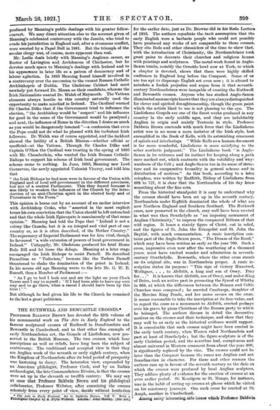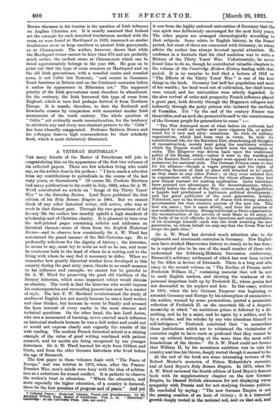111 - 1; RUTHWELL AND BEWCASTLE ' CROSSES, * PROFESSOR BALDWIN Bnown has devoted
the fifth volume of his monumental work on The 'Arts in- Early England to the famous sculptured crosses of Ruthwell in Dumfriesshire and Bewcastle in- Crunberland, and to that- other fine example of
early Northumbrian art, the Gospels of Lindisfarne, now pre-
served in the British Museum. The two crosses, which bear inscriptions as -well as' reliefs, have long been the subject of
controversy. The traditional' and accepted view' is that they
are Anglian 'work of the seventh or early eighth century, when the-Kingdom- of Northumbria after its brief period of prosperity
was hastening to decay. The heterodox view, expounded -by an American' philologist, Professor Cook, and by an Italian archaeologist, the late Commendatore Rhona, is that the crosses
were set up in the eleventh or twelfth century. We may say at once that Professor Baldwin Brown and his philological collaborator, Professor Weirder, after examining the croesea minutely from every point -of view,' decide hesitation
. . _ . . . .
• The' Arts in Earn Eng:arid. By G. D'alawin ffrown. Volt ,Wlitt a ltuelonacel,Oeseter by..a..mrne Wetetec JohninUitiv•- MC. beta
for the earlier date, just as Dr. Browne did in his Redo Lecture of 1916. The authors repudiate the• tacit assumption that the
early English were a barbaric people who could not possibly have produced any works of art comparable to these crosses. They cite Bode and other chroniclers of the time to show that, with the introduction of Christianity, the Northumbria/nil took great pains to decorate their churches and religious houses with paintings and sculptures. The metal-work found is Anglo. Saxon tombs, notably the Ormsido bowl now at York, to which a chapter is devoted, shows that there were highly skilled craftsmen in England long before the Conquest. Some- of us are too apt to disparage English art even now ; it is absurd to antedate a foolish prejudice and argue from it that seventh- century Icorthumbrians. were incapable of creating the Ruthwell and Beweastle crosses. Anyone who has studied Anglo-Saxon illuminated-manuseriptaknows that they are always distinguished for clever and spirited draughtsmanship, though the green paint which the artists liked to use is not pleasing to the eye. The Lindisfarne Gospels are one of the finest works produced in any country in the early middle' &gee, and they are indubitably Anglian in origin and mainly Teutonic in style. Professor Baldwin Brown contends with much force that the Lindisfarne artist was in no• sense a mere imitator of the Irish style, beet exemplified in the Book- of Kali, with its astonishing ornament of spirals and interlaeings. " While Kells ass human document is far more wonderful, Lindisfarne is more satisfying to the sober aesthetic judgment." Tho Lindisfarne book " is Anglo- Saxon in its reticence and its instinct for keeping along a .path once marked-out, which contrasts with the volubility and way- wardness-of the Celt ; and Anglo-Saxon too in its-sense' of' Mete- tore and its -comparative 'formality in general scheme and in dittribution of motives." As this book, according to a later colophon, was written -by Eadfrith, Bishop 'of Lindisfarne -from 698 to 721, it is clear that the Northumbria of his day knew something about the' fine arts: From• the histerical standpoint it is easy to understand why the crosses should' have been set up in the seventh century. Northumbria under Ecgfrith dominated- the whole of what are now Northern England and Southern Scotland. The Ruthwell cross, 'now preserved in the church, may well have been erected in what was then Strathclyde as "an imposing monument of Anglian Christianity," to impress the conquered Britons of that wild region. It bears a stately figure of Christ, cut in relief, and the' figures of St. John the Evangelist and St. John the Baptist, with much ornamentation. A runic inscription con- tains part of the Anglo-Saxon poem, " The Dream of the Rood," which may have been written as early as the year 700. Such a cross, impressive even now after the weathering of a thousand years, must have excited wonder and admiration in seventh- century Strathclyde. Bewcastle, where the other cross stands on' its original site, was in Northumbria proper. A runic in- scription states its purpose: " This sign of victory Hwaetred, Wothgaer, . . . to Alcfrith, a king and son of Oswy. Play for ..." It is known that Alcfrith, son of Oswy, and under-King of Deira, took an active part in promoting the Synod of Whitby in 664; at which the differences between the Roman and Celtic, Churches were composed ; he married Cuniburga, daughter of the Mercian King Penda, and her name occurs on the cross. It seems reasonable to take the inscription at its face-value, and to regard the cross as a monument to Alcfrith, erected perhaps over his grave by pious Christians of the Roman party to -which he belonged. Tho authors discuss in detail the decorative motives on the crosses and their technique, and show that they may well be as early as the historical' evidence would suggest It is conceivable that such crosses might have Seen erected in the early tenth century, when Wessex ruled Northumbria and part at least of Strathclyde ; but the figure-sculpture is of the early Christian period, and the acanthus leaf, conspicuous and almost universal' in Western ornament from' about the'year 800, is significantly replaced by the vine. The crosses could not be later than the Conquest because the runes. are Anglian and not Scandinavian in' character. For these and other reasons the authors sum up in favonrof the seventh century as the' date at which the crosses were produced by local Anglian sculptors. They adduce plenty of evidence for the erection of crosses at an even earlier period. St Kentigern or St. Mango, for instance. was in the habit of setting up crosses at-places which he visited ors his missionary 'journeys. One such cross he erected at St. Asaph, another in Cumberland, Athena many' interesting .side,istinas which:Profaner Baldwin,
Brown discusses in his treatise is the question of Irish influence on Anglian Christian art. It is usually assumed that Ireland set the example for such inscribed tombstones, marked with the cross, as were found at Hartlepool in 1833, inasmuch as similar tombstones occur in large numbers in ancient Irish graveyards, as at Clorunacnois. The author, however, shows that while the Hartlepool stones cannot be later than 875 and are probably much earlier, the earliest stone at Clonmacnois which can be dated approximately belongs to the year 890. He goes on to point out that the type of cross common at Hartlepool and on the old Irish gravestones, with a rounded centre and rounded arms, is not Celtic but Teutonic, " and occurs in Germanic Tomb furniture in Britain and on the Continent centuries before it makes its appearance in Hibernian art." The supposed priority of the Irish gravestones must therefore be abandoned. On the contrary, the Irish borrowed this type of cross from England, which in turn had perhaps derived it from Northern Europe. It is unsafe, therefore, to date the Ruthwell and Bewcastle crosses by comparison with somewhat similar Irish monuments of the tenth century. The whole question of " Celtic " art evidently needs reconsideration, for the tendency to attribute any and every non-classical pattern to the " Celts " has been absurdly exaggerated. Professor Baldwin Brown and his colleague deserve high commendation for their scholarly book, which is most elaborately illustrated.



































 Previous page
Previous page